[orc]The Home Minister told the Rajya Sabha that crores of people will get the benefit of CAA. The numbers from various sources however, present a very confusing picture. The government also doesn’t seem to have any conclusive data on the number of potential beneficiaries.
The Parliament passed the Citizen Amendment Bill- 2019 on 11 December 2019, and with the subsequent approval of the president, it is now an Act, popularly known as the CAA.
As per this amendment, any person belonging to one of the six religious communities i.e. Hindu, Sikh , Buddhist, Jain , Parsi or Christian from one of the three countries – Afghanistan, Bangladesh or Pakistan who entered India on or before 31 December 2014 would not be treated as an Illegal migrant. They would be also be entitled to apply for Indian citizenship by naturalization after a 5-year stay in India instead of the usual 11-year period. Factly’s detailed explainer on the CAA can be read here.

In his address to the Lok Sabha, the Minister for Home Affairs, Amit Shah, referred to persecuted minorities and that CAA is to provide relief for such minorities from these three countries. He also referred to the fall in numbers of these religious minority communities in the three countries.
However, no precise numbers were divulged about the presence of such illegal migrants currently in India or those who are expected to gain relief through this act.
In this story, we look at the various numbers relating to the migrants in India, that have been provided over a period of time by various government and other credible agencies to understand the extent of such people in India.
As per the Intelligence Bureau, ‘31,313’ persecuted minorities were granted LTVs
The Report of Joint Committee on the Citizen (Amendment) Bill -2016 was presented in both the houses of parliament in January 2019. The 2016 bill lapsed and hence a new bill called the Citizenship Amendment Bill, 2019 (CAB) was introduced in the current session of parliament.
The report of the joint committee cites the data provided by the ‘Intelligence Bureau’ (IB) about the number of people who may be immediate beneficiaries of a Citizen Amendment Bill.
As per this information, a total of 31,313 persons belonging to minority communities from these three countries have sought Indian Citizenship. These individuals have claimed religious persecution in their countries. Of these, 25,447 were Hindus, 5807 Sikhs and 55 Christians. Further, there were 2 Parsis and 2 Buddhists. The IB further stated that these persons have been granted Long Term Visas (LTVs).

Foreigners not of Indian Origin who need to stay in India for more than 180 days are required to have LTVs. The Government of India made provisions for providing LTVs to those from Pakistan, Afghanistan & Bangladesh, coming into India and seeking permanent settlement.
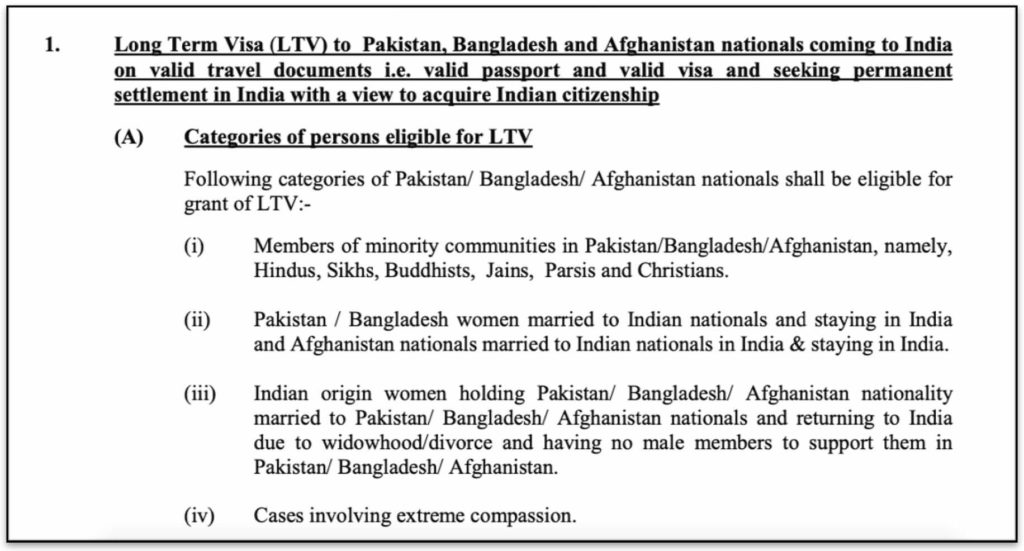
As per the guidelines, the foreign nationals seeking residency in India need to have valid travel documents i.e. a valid Passport of their country and a valid Visa.
In response to the Joint Committee, the Director of IB does not rule out the fact that there could be others from these three countries who have already secured citizenship in India by other means.
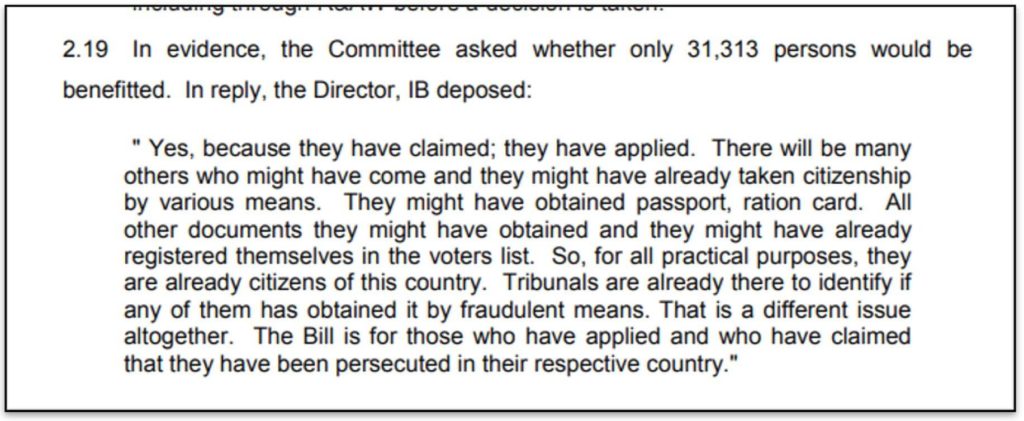
While IB states that the bill is aimed at those seeking citizenship due to the religious persecution, India has a track record of providing asylum as well as citizenship to foreign nationals who have escaped other countries due to other types of persecution as well.
2,738 Afghani & Pakistani migrants have been granted Indian Citizenship in last four years.
The Minister of State (Home Affairs) in his response in Rajya Sabha on 11 December 2019, provided information on migrants from Afghanistan and Pakistan who were provided Indian Citizenship over the last four years. It has to be noted that the religion of migrants who were granted citizenship prior to 2018 is not known since such data was not provided by the government.
As per this information, a total of 2,738 Afghani & Pakistani nationals were provided citizenship during 2016-2019. The provision for online capturing of data for the 6 minority communities is available only from 2018. A total of 927 Sikhs and Hindus were granted Indian Citizenship since then as per the data provided by the government in the Rajya Sabha.
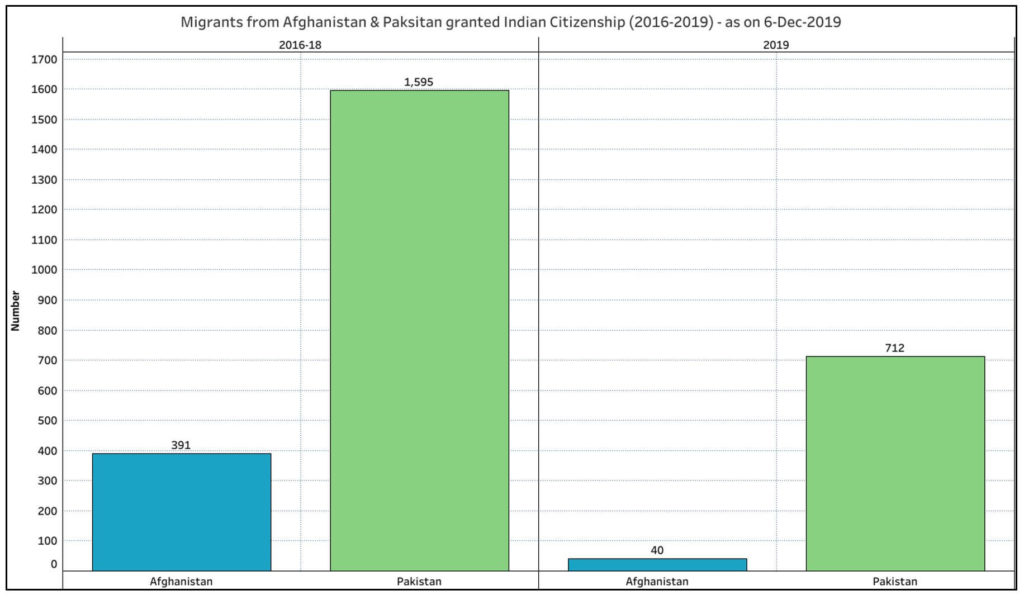
More than 4 lakh Sri Lankan and Tibetan Refugees entered India as per MHA
In its Annual Report (2018-19), Ministry of Home Affairs (MHA) stated that 3,04,269 refugees from Sri Lanka have entered India due to the ethnic conflict in Sri Lanka. These migrants entered India in various phases during the period of July’1983-August’2012.
These numbers include both: Sri Lankan Citizens and State-less people who aren’t conferred Sri Lankan citizenship and those who have not yet applied for Indian Citizenship. Of these 99,469 have been repatriated to Sri Lanka up to March 1995, post which no organised repatriation was done, with few of the refugees deciding to go back on their own.
MHA’s annual report also states that 60,674 refugees are currently staying in 108 refugee camps in Tamil Nadu and Odisha (107- Tamil Nadu, 1-Odisha). It goes onto state that there are 35,155 other refugees who are staying outside these refugee camps and are registered with the local police station.
Furthermore, India has agreed to repatriate 5.06 lakhs people of Indian origin from Sri Lanka along with natural increase, under India-Sri Lanka agreements of 1964,1974 & 1986. Of these, 3.35 lakh along with 1.26 lakh of natural increase belonging to 1,16,152 families have been repatriated in India between Oct’64 -Dec’06 as per MHA’s annual report.
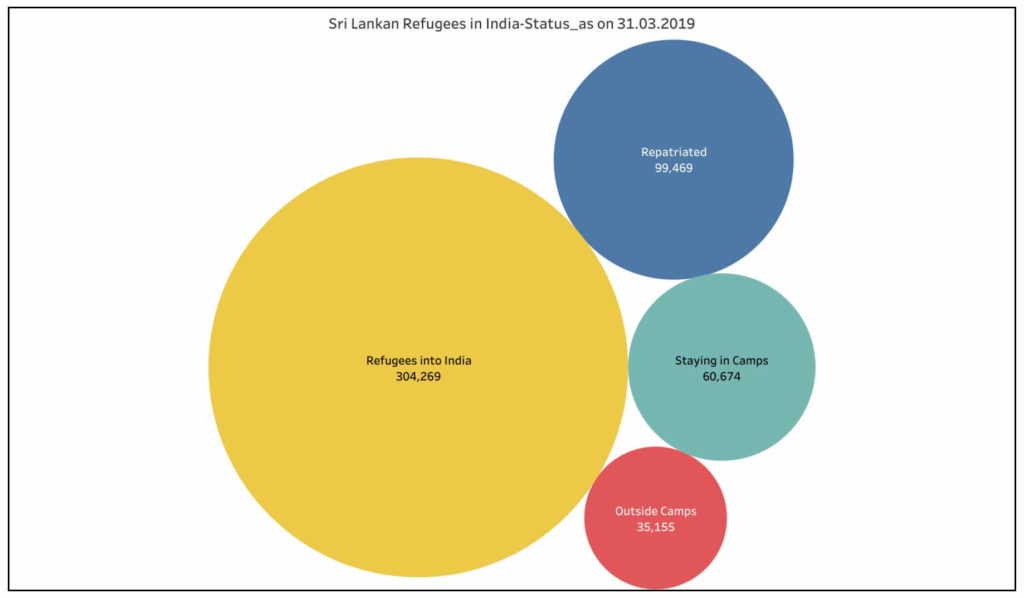
As of 30 June 2013, a total of 1,08,005 Tibetan refugees have settled in various states of India. Tibetan refugees have been entering India since Dalai Lama’s fleeing and coming to India in 1959. These refugees have been rehabilitated through various government schemes and measures. The support of India is limited to providing care and asylum with Tibetans retaining their ethnic identity.
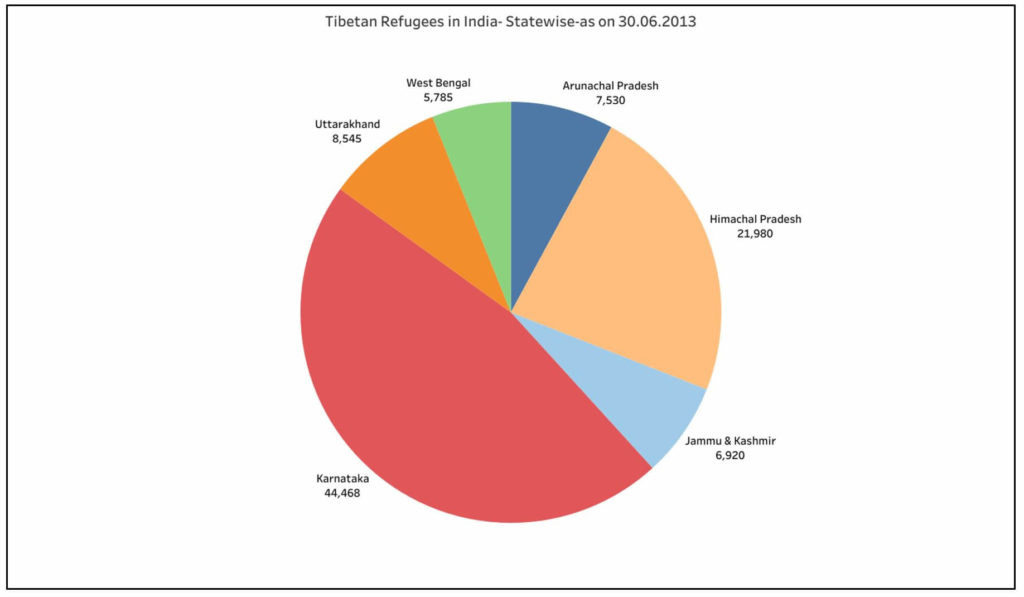
More than 1 crore displaced persons migrated to India from Pakistan & Bangladesh since 1947
Responding to a question in Lok Sabha on 28 July 2015, the government stated that 1,00,18,173 (more than a crore) displaced people have migrated from Pakistan to India since 1947 (both West Pakistan & East Pakistan – present-day Bangladesh).
Of these 89,04,215 migrants were from undivided Pakistan (i.e. West & East Pakistan) between 1947-1958 (as on 31 December 1958). These people were settled across 18 states of India.
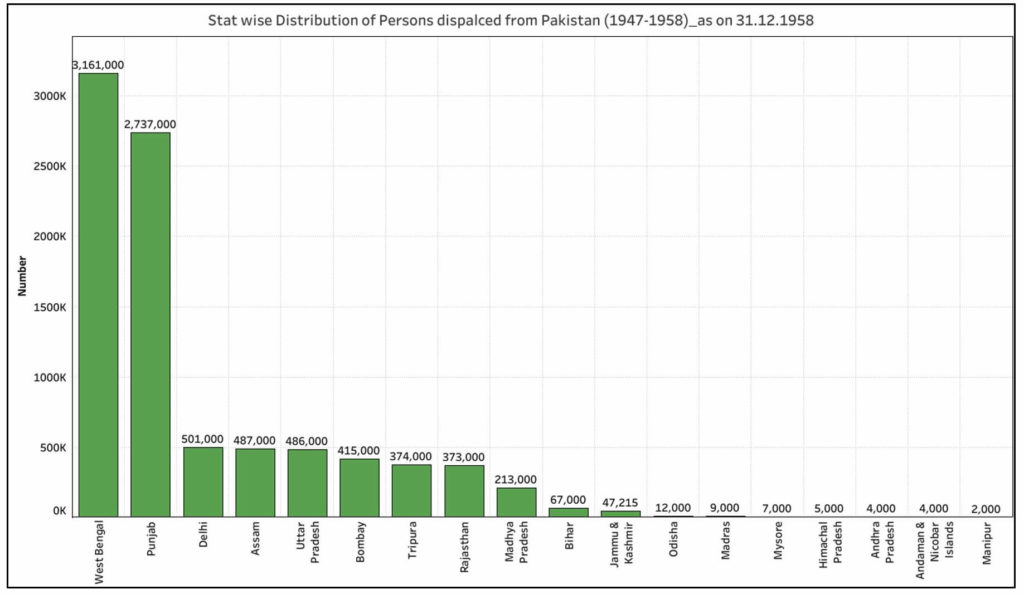
A further 11,13,958 people displaced from East Pakistan migrated to India between 1964-1971. They are distributed across the three States of West Bengal, Assam & Tripura.

Approximately 2.9 Lakh Stateless persons are residing in India
As per the information provided by the government in Lok Sabha on 01 March 2016, there are 2,89,394 stateless persons living in India as on 31 December 2014.
As per the definition of UNHCR (United Nations High Commissioner for Refugees), a stateless person is not a national of any country.

A total of 1,02,467 are from Sri Lanka who could be but not necessarily part of the 1,02,478 state-less individuals staying in Tamil Nadu. The highest number of State-less individuals are from Bangladesh with 1,03,817. As per the information, further 58,155 individuals from Tibet are state-less. Myanmar with 12,434 and Pakistan with 8,799 are other countries from where a significant number of stateless individuals have come over and are residing in India. Further, information regarding the home country of 19 individuals is not available and 29 identify as coming from Pakhtoon.
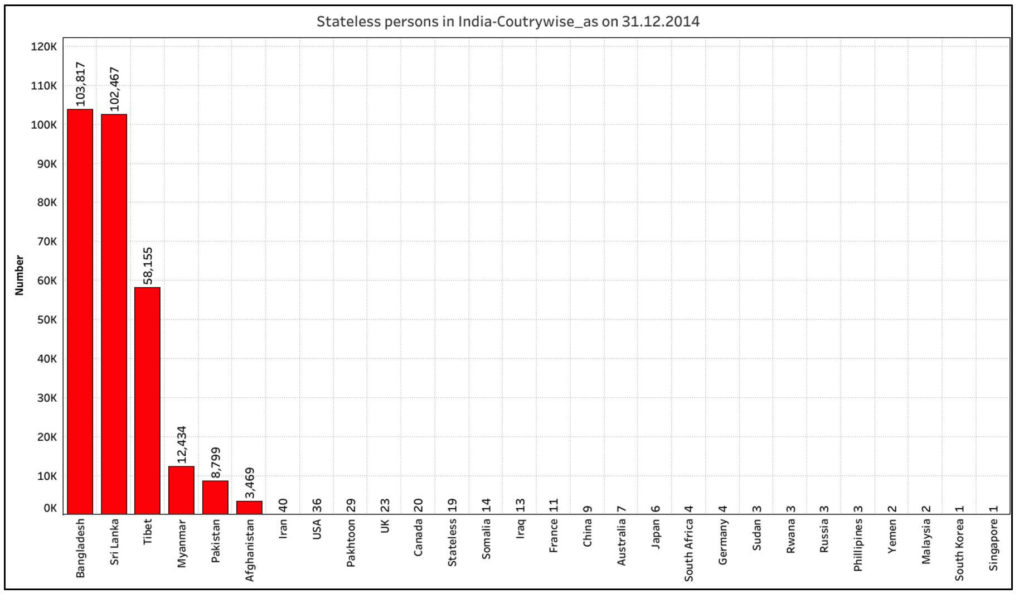
After Tamil Nadu, Chhattisgarh hosts the highest number of State-less persons in India with 62,890 Individuals. Karnataka, which has a sizeable Tibetan immigrant population has 34,348 state-less individuals.
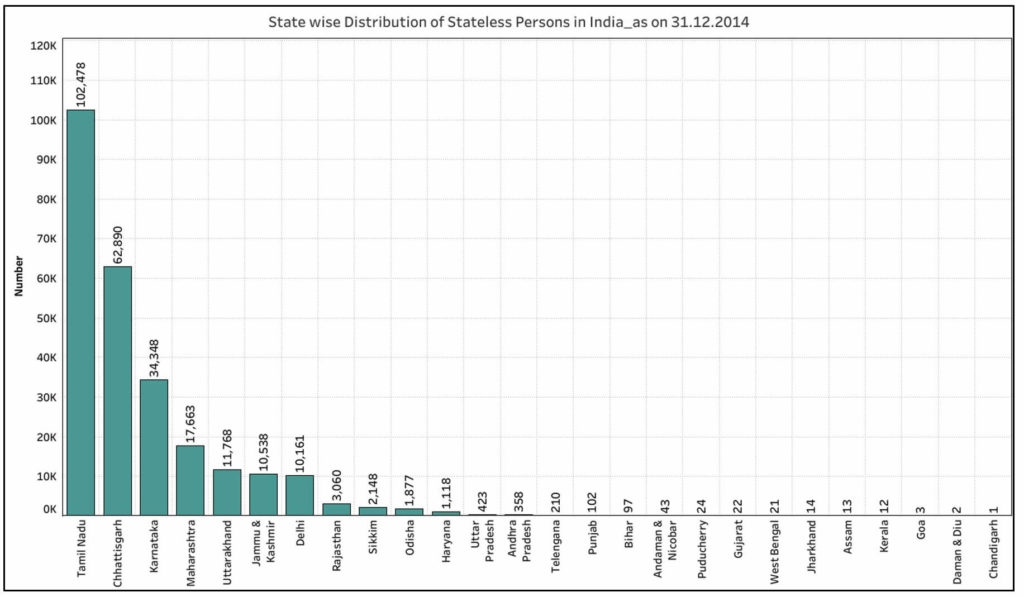
1.95 lakh refugees in India as per UN Report
As per UNHCR’s Global Trends Report-2018, India has 1,95,891 refugees by the end of 2018. Apart from these refugees, there are further 11,957 asylum seekers whose cases are pending.
As per the report, China and Sri Lanka are the countries of origin for the maximum number of refugees in India. While the number of refugees from Sri Lanka has gone down over a period of time, those from China has increased. This increase in migration from China could be because of the Tibetan refugees.
The report also states that there are a further 9,602 refugees internationally who have India as the country of origin. There are 51,812 individuals with India as origin who are seeking asylum globally, with other 216 categorised under ‘Others of concern to UNHCR’.
A majority of the new asylum seekers from Pakistan have sought asylum in Italy, followed by Greece, UK & Germany.
51.54 lakh Migrants in India as per UN Migrant report
As per the International Migrant Stock Report, India is host to 51,54,737 migrants from 36 countries as of mid-2019. Of these, the highest number of migrants are from Bangladesh with 31,03,664 followed by Pakistan with 10,82,917 migrants.
In 1990, the number of migrants from Bangladesh as per the International Migrant Stock Report was 43.75 lakhs which has decreased over the period. Similarly, the migrants from Pakistan in 1990, were 19.21 lakhs which fell in the subsequent years.
The number of Sri Lankan migrants has also reduced over the years while those from China has increased. As stated earlier, repartition and settlement of Sri Lankan migrants along with the settlement initiatives for Tibetan migrants could be the reason for these trends.
However, the reason for the fall in migrants from Bangladesh and Pakistan is ambiguous. No data is available to ascertain if the fall in migrants is due to them gaining citizenship or their going back to the respective home countries.
It has to be noted that the estimates provided in the International Migrant Stock Data of UN is based on the official national numbers from the population census, registers and representative surveys. This would mean that these number reported for the migrants in India is also as per the official information provided by the national authorities.
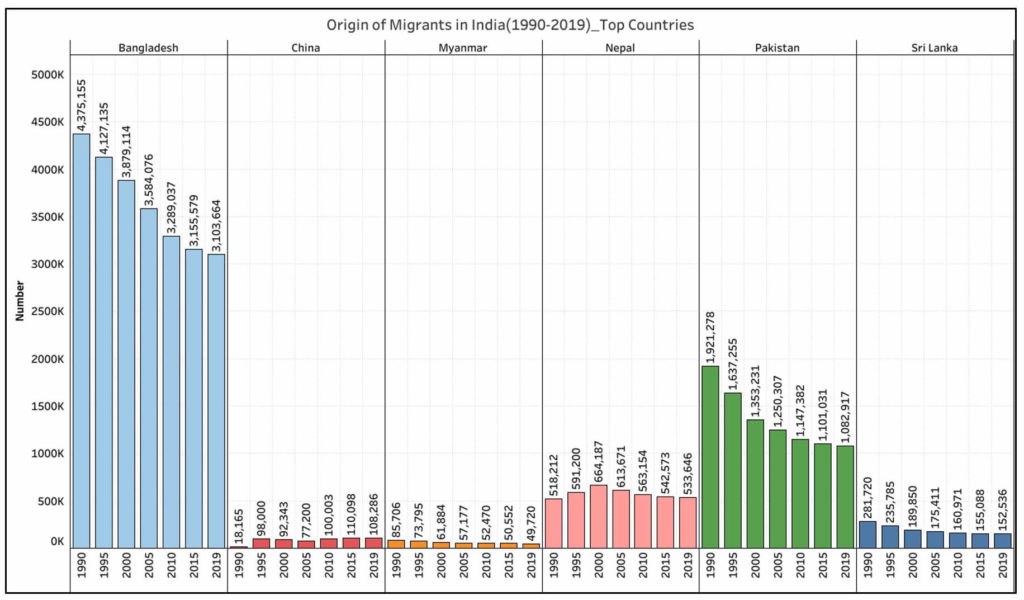
More than 2000 crores spent on rehabilitating migrants from Sri Lanka, Tibet & Bangladesh.
As per MHA’s Annual report, Government of India has spent Rs. 1021 crores in providing relief and accommodation of Sri Lankan Refugees between July’1983 – 31 March 2019. A further Rs. 34.81 crores are spent on providing relief and accommodation of Tibetan migrants across various states of India.
A further Rs. 1005.99 crores is being spent for rehabilitation of people returning from erstwhile Indian enclaves. There is also a Rs. 2000 crores package approved by Government of India as one-time settlement for 36,384 displaced families from Pakistan occupied J&K.
Ambiguity over the number of potential beneficiaries of CAA raises questions over the implementation
During the debate in parliament, the government has not provided any conclusive data about number of persons who stand to get citizenship with the CAA. Except for saying that crores of people will get the benefit, the Home Minister Amit Shah also did not provide any data on the number of potential beneficiaries.
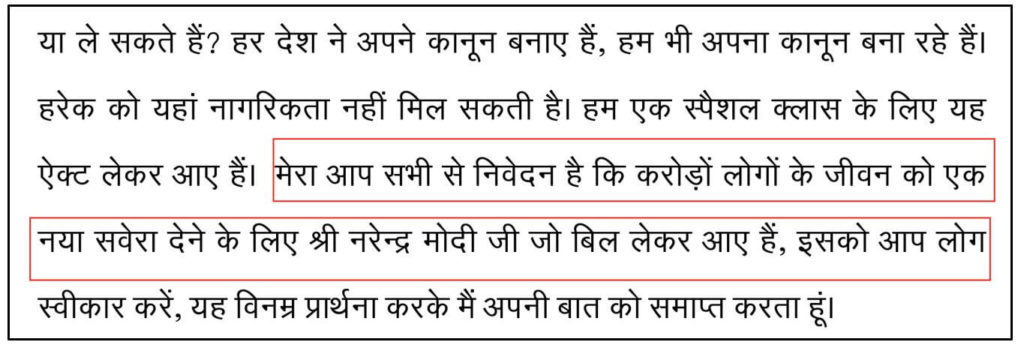
As highlighted in the story, India has earlier granted citizenship to people migrating from Pakistan and Afghanistan. While the religious data and the reason for them leaving their country of origin is unknown, 927 of those granted citizenship since 2018 belong to Hindu and Sikh Communities. Whether they fled the country of their origin because of religious persecution is also not known, which is the primary objective of the CAA.
Further, there is no data available on the current citizenship status of more than 1 crore migrants from Pakistan (both West & East) who came to India post-partition. Since CAA is meant to extend citizenship to those fleeing because of religious persecution, how many of this one crore, who may not have received citizenship so far would stand to benefit remains unanswered.
The case of Bangladeshi migrants is more complex. Different data sources indicate varied numbers, without any clarity on the current number of migrants in India. While there is a dip in official data as seen in UN report, the state of 40 lakh+ migrants who came to India us unknown. Religious classification & the criteria of religious persecution add to the complexity.
Meanwhile, CAA does not address the issue of near one lakh Sri Lankan migrants in India. There is also the case of 2.9 lakh state-less people some of who may get benefitted with CAA.
The UN report on refugees, while making a mention of refugees in India from China & Pakistan, does not categorically specify any refugees in India or those seeking asylum specifically from Pakistan, Afghanistan and Bangladesh.
Unless there is clarity on the numbers, the implementation of CAA would be difficult. Further, the procedure to be followed for those seeking citizenship under CAA is also not known since the rules are not yet framed. Without any such data, it will be difficult to ascertain the financial burden on the country and the burden on various states once citizenship is extended to these people.
The number provided by IB as immediate beneficiaries of CAA is just around 31000 and this raises questions over the Home Minister’s claim of crores of beneficiaries. Meanwhile, the ambiguity around prospective numbers could impact the preparedness of the country to absorb them. While religion is the basis for CAA benefits, culture and language are other vital aspects which would influence the assimilation process of the beneficiaries. As mentioned earlier, 107 out of 108 camps for Sri Lankan refugees are in Tamil Nadu. There is also the larger question of resettlement of the migrants from Bangladesh, which has the largest numbers since the North-East is staunchly against citizenship to these migrants.


